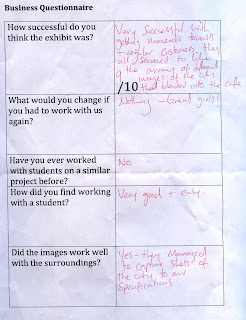To get a better idea of how the Roman Baths exhibitions were planned and put up we went back to speak to the curator of the museum, Lindsay Bradley. She had prepared a small presentation for us about the way exhibits are planned and carried out.
The first important stage of creating an exhibition is to decide on a theme. This will create an opportunity for every aspect of the show to link and it ties all of the artefact and information together. The theme should be relevent to what you are presenting or what your client wishes.
The next stage is research. Research is important so that you get all of your facts right. you want all of the information you provide to be correct or it could lead to embarrasment. When researching you should use primary sources such as field work which means going out and doing your own research as well as researching from secondary sources such as the web and books.
The third important thing to consider is the target audience. A lot of people visit the museum from tourists to children so you have to make sure you have covered as many target audiences as you can. The audience can include tourists, children and people with disabilities. To prepare for this you should make sure measures are in place such as, ramps for disabled or braille for the blind. There are also aspects such as writing difficulties as children or foreign people find it difficult to read capital letters. to accompany text there could also be images, speech or projections to help illustrate your information or hand out leaflets so the audience can process the information at their own pace, it is very important for the audience to feel relaxed. Interactive services are also very successful such as touch screen projectors or items the audience can touch or feel.
The next stage of creating your exhibition is planning, this can also be the most important stage. Things you need to consider are contents of the show, space available, text and time limits. In terms of funding there are often items which can be borrowed or re-used from a previous show. you can also apply for government funding and borrow from other establishments or swap items.
In terms of advertising there are ways of making things less expensive such as creating your own adverts and displays instead of asking a printer or another company to do it. you can also collect items which can be reused such as leaflets or posters.
A big issue which may affect a show is lighting. A lot of materials are light sensetive and the colour can fade which means keeping them on display can be an issue. The Roman Baths museum uses a lot of materials such as old relics, woods, organics and paper which if exposed to too much of the wrong kind of light can become discoloured and damaged. other elements that can cause damage are gas, pests, vandalism, moisture and temperature. As I am only displaying photographs for a short period of time I'm sure I wont have to worry about damage apart from possibly customers vandalising the work.
The next stage of producing a show is installation. The preparation is very important in the way you prepare your artefacts properly and allow enough time to do everything properly. You will need to make a list of everything you need as if you forget important things such as artefacts or tools this will slow the whole process down and you may not reach your deadline.
On average it should only take two to three weeks to put up and plan an exhibition depending on the scale of the exhibition. You should also get people to help you if you feel you cannot do it all alone. An important thing to do is gett feedback a each stage as this will tell you if you are doing anything right or wrong.
In todays society, social networking is a huge part of advertising so you could use aspects such as facebook or twitter to advertise your event.

















































